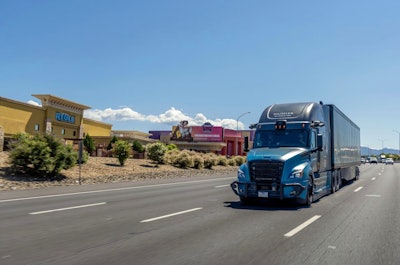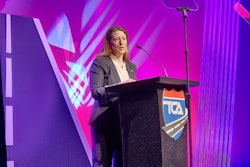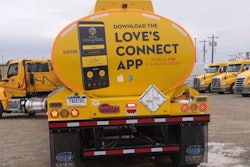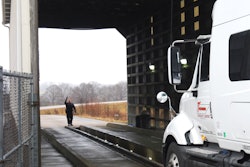
While California is reporting a sharp uptick in autonomous vehicle testing, some industry leaders are questioning the overall value of the data given the Golden State’s stance against larger commercial AVs.
The California Department of Motor Vehicles recently reported a 21% year-over-year increase in the number of miles autonomous vehicles drove in the state on public roads. During 2022, AVs drove 5.7 million miles, or a million more miles than 2021. However, those miles are limited to vehicles weighing no more than 10,001 pounds, which makes only Class 1 and 2 AVs eligible for testing in the state.
The Autonomous Vehicle Industry Association, an advocacy group that counts some of the biggest AV players in the nation among its members, is pleased to see California’s gains in AV testing but also concerned about policy there that excludes larger autonomous vehicles.
“California is a leader in AVs with residents reaping the benefits of everything from ride hail in San Francisco and Los Angele, to takeout deliveries and meal services with food banks,” said AVIA Executive Director Jeff Farrah.
“However, California runs the risk of getting left behind on autonomous trucks, which are forbidden from deploying in the state,” Farrah continued. “One study found that, over time, AV trucks will create thousands of jobs in the state while spurring greater efficiency, investment and economic growth. We encourage state regulators to begin a rulemaking to permit AV trucks so that autonomous trucks can deliver safety and economic benefits.”
[Related: Pronto focusing more on off-road autonomy]
According to the National Institute for Occupational Safety and Health, large truck accidents in California in 2020 ranked among the deadliest in the nation following Texas and Florida. Truck accidents, fatal or not, have frequently led to costly settlements and nuclear verdicts, setting carriers back millions of dollars.
Farrah said AVs can help reduce accidents, which makes larger AV testing in California all the more important.
“U.S. DOT has affirmed that human behavior is the overwhelming factor in crashes,” he said. “In contrast to human drivers, AVs do not drive impaired, distracted or drowsy. The technology also stands to enhance mobility, improve supply chain resilience, create jobs and boost economic growth. To ultimately achieve these broad benefits, however, the U.S. must put in place a federal policy framework supporting the safe and timely deployment of AVs.”
An excerpt from AVIA’s recently published Federal Policy Framework for Our AV Future states that nationwide AV regulations should “apply to all vehicle classes and types. This is consistent with traditional practice, as the Federal Motor Vehicle Safety Standards (FMVSS) already apply to all motor vehicles, regardless of type, including commercial motor vehicles.”
[Related: Torc Robotics truck offers safe, boring ride]
Torc Robotics industry partnership leader Walter Grigg pointed out that while California’s AV data, including its driverless statistics, provides insights into Class 1 and 2 AV performance, the numbers don’t mean much to AV players operating in the remaining six vehicle classes that include millions of trucks and vans.
“The data from the California autonomous miles reporting is not a direct comparison to trucks because it features passenger cars within specific operational design domains,” Grigg said. “Driverless passenger car tests are often gated to specific neighborhoods or cities.”
Autonomous trucks hit another pothole
Of the 5.7 million miles recorded by AV companies in California last year, 5.1 million were with a safety driver while 622,257 miles were driverless.Proponents advocating for autonomous trucks in California, including driverless testing, were hit with some tough news in January when California lawmakers Cecilia Aguiar-Curry (D) and Tom Lackey (R) introduced a bill that would impose a de facto ban on autonomous trucks in the state by requiring a human operator behind the wheel.
CCJ Chief Editor Jason Cannon reported this week that despite a recent workshop to discuss loosening testing restrictions the state is drifting farther from allowing driverless technologies on its roadways.
Amid pushback from AV stakeholders, AB316 passed out of the state Assembly Transportation Committee Monday and now moves to the Committee on Communications & Conveyance.
[Related: Driverless truck ban gaining traction in California]
In advance of the meeting this week, more than 43 organizations signed a letter for the record opposing AB316, including AVIA, CalChamber, California Small Business Association, U.S. Xpress (CCJ Top 250, No. 19), California Manufacturers & Technology Association, California Hispanic Chamber, California-based AV companies and more.
While going driverless is an ongoing goal among AV companies, getting there with a Class 8 truck will take some time.
“We do not plan to remove the safety driver until we have deemed it is safe,” Grigg said. “Our focus is on developing the product holistically and a system that we have validated and verified to deploy. Our approach will allow for continued development without the need to perform truly driver out tests until the product is ready.”
TuSimple, which became the first company in the world to successfully complete a driverless run in a Class 8 when its AV technology traversed Arizona streets and highways in 2021, is steering away from that approach over the next two years.
“The driver-out runs that were completed in 2022 were in order to validate the company’s technology,” said Ryan Amerman, TuSimple’s vice president of capital markets and business development. “With that completed, our work in 2023 and 2024 will be more focused on validating our business model. This will include expanding our operation design domain and nighttime to daylight, and the vast majority of this testing will be done with a driver inside our truck.”












